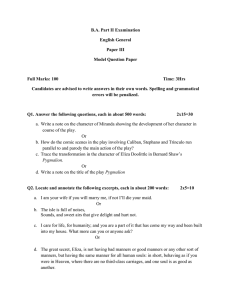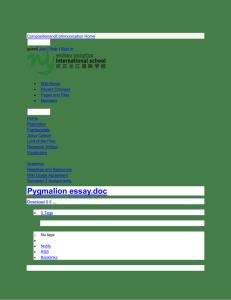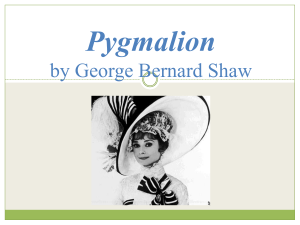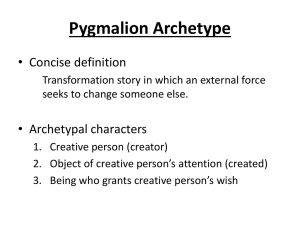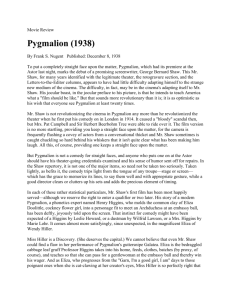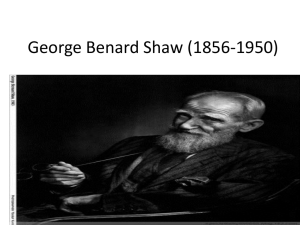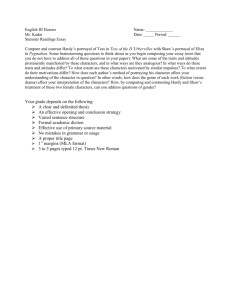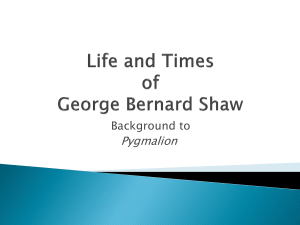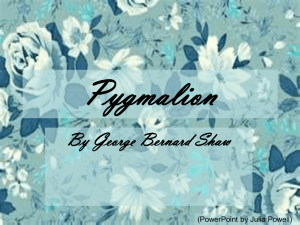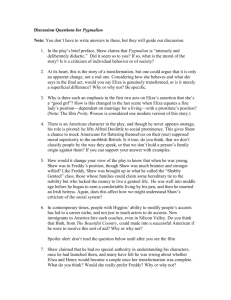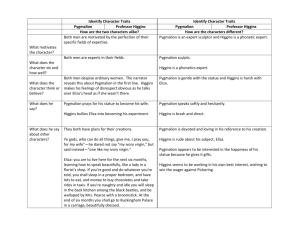Pygmalion: Language, Class & Education - Presentation
advertisement
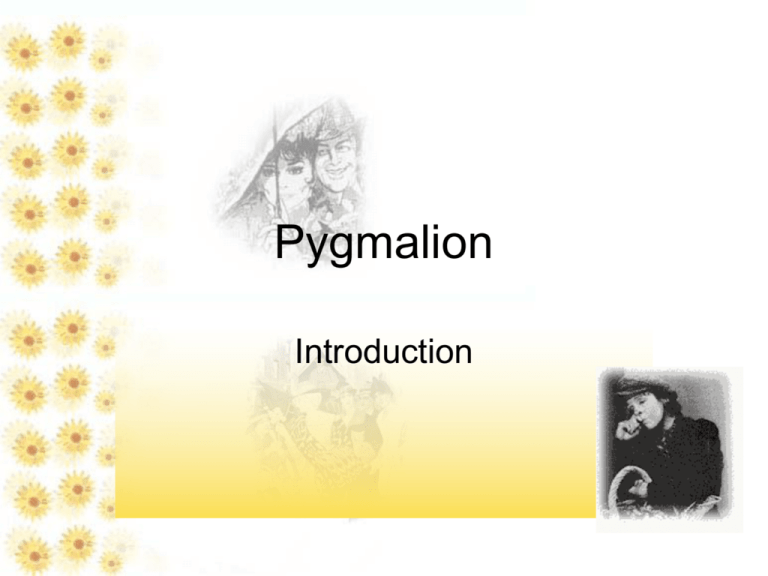
Pygmalion Introduction Outline Introduction 1. Story vs. Drama, Comedy 2. George Bernard Shaw, 3. the Myth & the Play 4. Pygmalion & My Fair Lady 5. Social Background: Language & Class 6. Preface 7. The Play as a Whole Introd (1): A play and a story (textbook pp. 1125-) Play (read and performed) Story (read) Plot Act/Scene Stage* & Stage directions (gestures, costumes, stage prop, sound and lighting, etc.) Dialogue – more (monologue, aside, soliloquy) Characters (Character list, showing their relations) Theme Readers: embodiment of script (actors, directors); Audience of performance time limit, etc.. Plot Narrator: Narration & Description Dialogue Characters Theme Readers Comedy (textbook Glossary A2 ) • Evokes laughter at – The characters’ mechanical and contradictory actions; – Exaggeration & a degree of improbability (a. richness of life; b. surprise; c. improbable situations) – The characters’ ideals (seemingly trivial the tragic characters’ ideal). • A degree of absurdity in the characters’ behavior the reader feels superior and laughs at the characters; – A. Social Foibles(弱點): characters defined primarily in terms of their social identities and roles. Comedy of Manners – B. Universal absurdity perceived so that the reader identifies with the absurd action and laughs with the characters. (Waiting for Godot” 1. George Bernard Shaw (1856-1950) Shavian (Shaw's) Style: • stage direction --economical exposition and suggestive of social background; • prefatory essay--used to express his doctrines; • discussion in (and around) the play. Sometimes Shaw calls his own plays Problem Play, Discussion Drama, Play of Ideas. He also claims that "[p]rimarily, [his plays] are not plays: they are tracts in dramatic forms." He regards social criticism as the most important function of all art. (A Guide to Bernard Shaw, Edward Wagenknecht, 1929, reissued 1971 pp. 3, 5, 16, 17) 2. Pygmalion: the Myth and the Play • In Ovid's Metamophosis, Pygmalion is a sculptor who is not interested in women. Pygmalion, however, finds himself in love with his sculpture, Galatea, and he caresses her and offers her with all the gifts women like. At the end, Venus realizes his wish and turn Galatea into a real woman. – Who is the Pygmalion in the play? – Why is the play “a Romance in Five Acts”? – The Sequel provides some sort of explanation. 2. Note: Romance (1. The improbabl, 2. adventure, 3. love) • 傳奇 浪漫小說 • An extended fictional prose narrative about improbable events involving characters that are quite different from ordinary people. e.g. Knights on a quest for a magic sword and aided by characters like fairies and trolls.(ref. http://www.virtualsalt.com/litterms.htm ) • Medieval Romance – King Arthur and RoundTable Knights • 19th century: Tales which are adventurous and exotic. • 20th century –today: formulaic love story (e.g. family romance), or Lord of the Rings (fantasy + romance) • Does Pygmalion involve love and adventure? Pygmalion & My Fair Lady Pygmalion 1938-- (film) scripted by GBS 1984-- (play, Peter O'Toole at the Shaftesbury Theatre) 1981-- (film) Pygmalion See here: My Fair Lady (musical) Popular Pygmalion Videos 1956 – Julie Andrews 1964 -- Audrey Hepburn Pygmalion Main Themes: Language, Class & Education 3. Language and Class Differences in (late) 19th-century England 1. Language – Queen’s English – There was then an attempt at having a nationwide spoken standard, known as "the Queen's English." Cockney English is the exact opposite to “Received Pronunciation,” denoting one’s lack of education. 2. The rise of the middle class– a. b. More and more businessmen and their families prospered and imitated the upper classes; they can even buy themselves some titles. To look classy, they also try to imitate the manners and accent of the upper class. The upper class -- subtle distinctions became all-important. Aristocrats tried to maintain their superiority by glorifying attributes that could not be bought easily, such as family history, refined social graces, and old traditions.” (ref LRC) 3. Language and Class Differences: Then and Now 1. Queen’s English (ref.: http://www.ic.arizona.edu/~lsp/QueensEnglish.html examples of Queen’s English and Cockney here.) -- “the monarch’s usage of the language should be a model in speech and writing” (Wales, 1994). -- the King’s English= standard English in written form (since James I in 16th/17th centuries). 2. Nowadays Queen Elizabeth speaks Queen’s English, but the younger generations of the royal family today (e.g. Princess Di and Prince Edward) speaks a mixture of cockney and RP. 2. World englishes – in Hong Kong, Singapore, Australia, Canada, the U.S., the Caribbean area, etc. 4. Science and the Preface • The center of the play: Eliza as "the most absorbing experiment [Higgins] ever tackled." • What does science bring to society? Does it solve problems or create problems? This has been a question asked since the rapid scientific developments in the 19th century England. – Darwin's Origin of Species (1859) – the discovery of the x-ray, the electron, and radioactivity science in 1890’s (ref. LRC) • GBS is interested in both science and phonetics (in development of a more complete alphabet for everyday use). • Does this make Henry Higgins a “hero” in the play? Preface: A Professor of Phonetics. • The English have no respect for their language, and will not teach their children to speak it. • The reformer England needs today is an energetic phonetic enthusiast: that is why I have made such a one the hero of a popular play. • Henry Sweet -- His true objective was the provision of a full, accurate, legible script for our noble but illdressed language; but he was led past that by his contempt for the popular Pitman system of shorthand, which he called the Pitfall system. • It [the play] is so intensely and deliberately didactic, and its subject is esteemed so dry, that I delight in throwing it at the heads of the wiseacres (自作聰明者 ) who repeat the parrot cry that art should never be didactic. • Eliza’s change: neither impossible nor uncommon. The Play as a whole Act 1 – in front of St. Paul’s The meeting of the crowd and the major and minor characters. Act 2 – at Higgin’s Act 3 – At-Home Day of Mrs. Higgins’ The beginning of the ‘experiment’ and the bet; Mr. Doolittle; (*Eliza’s practice) The first test; *the Embassy’s party (beginning part) Act 4 – at Higgin’s After the Embassy’s banquet Act 5 – at Mrs. Higgins’ The very next day, confrontation of Eliza and Higgins. * Added for the 1938 Film version Next Time 1. Read Act I (social microcosm) & Act II (as much as possible or the Beginning of Eliza’s Education/Transformation) 2. Answer 1 question online and in class 3. Get the play performance team organized Act 1: Class Discussion – Character and Theme *Give the names of those who answer the group's questions. **Give quotes to support your answers. Group 1&2) Eliza: What is she like as a flower girl? How is she treated by the mother and daughter differently? Group 3&4) The Mother, the Daughter (Mrs. Eynsford-Hill & Clare) and the Crowd: What do they each care about? Do they mix well with the crowd? What voices do you hear of the crowd? Group 5&6) The Two Scientists (Higgins & Pickering): Do you have any experience similar to Act I? Why is the Note-Taker (Higgins) offensive? Why is accent important to him? What do you think about people speaking in different accents? Group 7&8) The setting: read the stage direction to find out more about it. How is the setting important Group 9&10) Theme: How does Act I present the London society at the time? Group 11&12) Relevance: After reading Act 1, what do you think the play is about? Are there any stories you can associate with this play? How? Note: Character Types Minor Ones: • The Upper Class vs. the Flower Girl – How would you characterize the traits and relationship of the mother (Mrs Eynsford Hill ), daughter(Clara Eynsford Hill), and son (Freddy Eynsford Hill)? – How would you compare and contrast them with the flower girl (Eliza Doolittle)? Major Ones: – Two Scientists: How would you describe the gentleman (Pickering)? – How does he compare and contrast with the note-taker (Higgins)? – Pay attention to their different treatments of the flower girl. • The others (like chorus) –their functions? Every Group: Characters & Theme About the story you chose, or Pygmalion 1. What is your text? What is the possible theme you want to deal with? 2. What major characters are you going to have? How are they characterized? How will you show their features besides dialogue and action, via gestures, clothing, symbols? 3. Will there be minor characters? Their roles? And chorus (by-standers and general public)? 4. Are there any symbols associated with them? Group Work: Job Division • Find a group leader from each of the 12 groups • All: Choose a Text 1. Director - 1 2. Script Writer (& Prompter)-- 2 persons 3. Stage Manager (in charge of recording group meetings and work journals every week) –2 persons (group leader from each) 4. Actors/Actresses --? 5. Backstage Crew --3? (Wed noons –for costumes and light) 1. 2. Sound Set and Property 3. Costume and Makeup 3 questions in 3 weeks = 4 persons one question with ppt presentation Mini Play Contest: Tentative Schedule Play 10月31日 General Introd Act I and Act II. (pp. 1111月7日 37) 11月14日 Act II & III (pp. 38-71) 11月21日 Act III-IV (pp. 71-87 + Act V) 11月28日 Act V and Postscript 12月5日 Mini Play Preparation Poetry I: Lyric and Tone 12月12日 Performance Day Group Job Division Character Analysis & Theme Line Reading & Creative Adaptation(script ready) Performance & Set and Prop Theme and Overall Presentation Rehearsal 12/10 (12:15-3:30)
